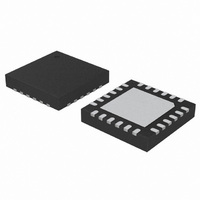C8051F338-GMR Silicon Laboratories Inc, C8051F338-GMR Datasheet - Page 125

C8051F338-GMR
Manufacturer Part Number
C8051F338-GMR
Description
IC MCU 16K FLASH 24QFN
Manufacturer
Silicon Laboratories Inc
Series
C8051F33xr
Specifications of C8051F338-GMR
Core Processor
8051
Core Size
8-Bit
Speed
25MHz
Connectivity
SMBus (2-Wire/I²C), SPI, UART/USART
Peripherals
POR, PWM, Temp Sensor, WDT
Number Of I /o
21
Program Memory Size
16KB (16K x 8)
Program Memory Type
FLASH
Ram Size
768 x 8
Voltage - Supply (vcc/vdd)
2.7 V ~ 3.6 V
Data Converters
A/D 16x10b; D/A 1x10b
Oscillator Type
Internal
Operating Temperature
-40°C ~ 85°C
Package / Case
24-QFN
Processor Series
C8051F3x
Core
8051
Data Bus Width
8 bit
Data Ram Size
768 B
Interface Type
I2C, SPI, UART
Maximum Clock Frequency
25 MHz
Number Of Programmable I/os
21
Number Of Timers
4
Operating Supply Voltage
2.7 V to 3.6 V
Maximum Operating Temperature
+ 85 C
Mounting Style
SMD/SMT
3rd Party Development Tools
KSK-SL-TOOLSTICK, PK51, CA51, A51, ULINK2
Development Tools By Supplier
C8051F336DK
Minimum Operating Temperature
- 40 C
On-chip Adc
10 bit
On-chip Dac
10 bit
Height
0.73 mm
Length
4 mm
Supply Voltage (max)
3.6 V
Supply Voltage (min)
2.7 V
Width
4 mm
Lead Free Status / RoHS Status
Lead free / RoHS Compliant
Eeprom Size
-
Lead Free Status / Rohs Status
Details
Other names
Q4962654
T1084322
T1084322
- Current page: 125 of 226
- Download datasheet (2Mb)
Registers XBR0 and XBR1 are used to assign the digital I/O resources to the physical I/O Port pins. Note
that when the SMBus is selected, the Crossbar assigns both pins associated with the SMBus (SDA and
SCL); when the UART is selected, the Crossbar assigns both pins associated with the UART (TX and RX).
UART0 pin assignments are fixed for bootloading purposes: UART TX0 is always assigned to P0.4; UART
RX0 is always assigned to P0.5. Standard Port I/Os appear contiguously after the prioritized functions
have been assigned.
Figure 20.5 shows an example of the resulting pin assignments of the device with UART0, SMBus, and
CEX0 enabled, the XTAL1 (P0.2) and XTAL2 (P0.3) pins skipped (P0SKIP = 0x0C). UART0 is the highest
priority and it will be assigned first. The UART can only appear on P0.4 and P0.5, so that is where it is
assigned. The next-highest enabled peripheral is the SMBus. P0.0 and P0.1 are free, so the SMBus takes
these two pins. The last peripheral enabled is the PCA’s CEX0 pin. P0.0, P0.1, P0.4 and P0.5 are already
occupied by higher-priority peripherals. Additionally, P0.2 and P0.3 are set to be skipped by the crossbar.
The CEX0 signal ends up getting routed to P0.6, as it is the next available pin. The other pins on the
device are available for use as general-purpose digital I/O or analog functions.
Important Note: The SPI can be operated in either 3-wire or 4-wire modes, pending the state of the
NSSMD1–NSSMD0 bits in register SPI0CN. According to the SPI mode, the NSS signal may or may not
be routed to a Port pin.
SF Signals
PIN I/O
TX0
RX0
SCK
MISO
MOSI
NSS
SDA
SCL
CP0
CP0A
SYSCLK
CEX0
CEX1
CEX2
ECI
T0
T1
SF Signals
1
VREF IDA
Port pin potentially available to peripheral
Special Function Signals are not assigned by the crossbar.
When these signals are enabled, the CrossBar must be
manually configured to skip their corresponding port pins.
0
0
1
0
Figure 20.5. Crossbar Priority Decoder Example
x1
2
1
P0SKIP[0:7]
x2
3
1
P0
4
0
5
0
CNVSTR
6
0
7
0
0
0
Rev.1.0
1
0
2
0
P1SKIP[0:7]
Notes:
1. NSS is only pinned out in 4-wire SPI Mode
2. Pins P2.1-P2.4 only on QFN24 Package
3. Pin 2.0 unavailable on crossbar in QFN20 Package
3
0
P1
4
0
5
0
C8051F336/7/8/9
6
0
7
0
0
0
P2SKIP[0:3]
1
0
2
P2
2
0
2
3
0
2
4
2
125
Related parts for C8051F338-GMR
Image
Part Number
Description
Manufacturer
Datasheet
Request
R
Part Number:
Description:
SMD/C°/SINGLE-ENDED OUTPUT SILICON OSCILLATOR
Manufacturer:
Silicon Laboratories Inc
Part Number:
Description:
Manufacturer:
Silicon Laboratories Inc
Datasheet:
Part Number:
Description:
N/A N/A/SI4010 AES KEYFOB DEMO WITH LCD RX
Manufacturer:
Silicon Laboratories Inc
Datasheet:
Part Number:
Description:
N/A N/A/SI4010 SIMPLIFIED KEY FOB DEMO WITH LED RX
Manufacturer:
Silicon Laboratories Inc
Datasheet:
Part Number:
Description:
N/A/-40 TO 85 OC/EZLINK MODULE; F930/4432 HIGH BAND (REV E/B1)
Manufacturer:
Silicon Laboratories Inc
Part Number:
Description:
EZLink Module; F930/4432 Low Band (rev e/B1)
Manufacturer:
Silicon Laboratories Inc
Part Number:
Description:
I°/4460 10 DBM RADIO TEST CARD 434 MHZ
Manufacturer:
Silicon Laboratories Inc
Part Number:
Description:
I°/4461 14 DBM RADIO TEST CARD 868 MHZ
Manufacturer:
Silicon Laboratories Inc
Part Number:
Description:
I°/4463 20 DBM RFSWITCH RADIO TEST CARD 460 MHZ
Manufacturer:
Silicon Laboratories Inc
Part Number:
Description:
I°/4463 20 DBM RADIO TEST CARD 868 MHZ
Manufacturer:
Silicon Laboratories Inc
Part Number:
Description:
I°/4463 27 DBM RADIO TEST CARD 868 MHZ
Manufacturer:
Silicon Laboratories Inc
Part Number:
Description:
I°/4463 SKYWORKS 30 DBM RADIO TEST CARD 915 MHZ
Manufacturer:
Silicon Laboratories Inc
Part Number:
Description:
N/A N/A/-40 TO 85 OC/4463 RFMD 30 DBM RADIO TEST CARD 915 MHZ
Manufacturer:
Silicon Laboratories Inc
Part Number:
Description:
I°/4463 20 DBM RADIO TEST CARD 169 MHZ
Manufacturer:
Silicon Laboratories Inc










